Culture Watch

HIGHBROW FILM criticism and fanboy comment pages alike often manifest as if their purpose is to make snarky points about who knows how much about what. Whether in an academic journal or on Reddit, film criticism can either get the point or be the point. We can either convince ourselves that we exist to show the world how smart we (think we) are—or to facilitate a conversation about the purpose of art that’s spacious enough to stimulate both the heart and the mind.
The lack of clarity about such purpose means that it has to be continually reasserted, so here goes: The purpose of art is to help us live better. I contend that this is the primary evaluative lens through which we should watch. Of course aesthetics, craft, and content matter, but how I watch films depends at least as much on the notion that art emerges from a human creative impulse that is at its best directed at the common good.
The protagonist of the new documentary The Overnighters has made a similar shift in consciousness regarding his own vocation. North Dakota pastor Jay Reinke understands that the purpose of church isn’t far different from that of art, and he opens his building to economically disenfranchised folk trying to find a job in the oil boom, letting them stay overnight despite local suspicions. It’s a manifestation of Christian vocation mingled with lightly ringing alarm bells—the pastor appears to be a Lone Ranger, not collaborating with supportive church leaders or members; the jobs are in an environmentally degrading industry—and a picture of community service that seems at once miraculous and exhausting.
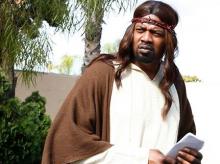
JESUS RETURNED this past August. Or at least a new depiction of him appeared on late-night cable television, in the comedy Black Jesus, created by Aaron McGruder (of The Boondocks). There was no rapture, and no subsequent tribulation, beyond what passes for normal these days. Instead Jesus appeared, as he did in Palestine, in a manner both obscure and mysterious. And, again, his incarnation became a scandal among some of the powerful and pious.
In Black Jesus, on the Adult Swim network, the second person of the Trinity turns up one day on the streets of Compton, a very poor and heavily African-American community in southern Los Angeles County. Played by a tall and beefy Gerald “Slink” Johnson, Jesus walks the streets in his first century robe and sandals, but with his hair in a Tina Turner perm. Aside from the eccentric get-up, this Jesus fits right into his surroundings. He has no cash, and no place to lay his head. But that goes for plenty of Comptonites. He enjoys malt liquor and marijuana, just as much as he did good wine back in the day at Cana. He’s still preaching and practicing unconditional love, forgiveness, nonviolence, and service to all, but his street talk averages about 1.5 bleeps per sentence.
There’s plenty that’s problematic about Slink Johnson’s character. For one thing, I can’t imagine the Jesus I know using the disrespectful canine term for women so freely or being quite so nonjudgmental about the marijuana trade. But neither does this depiction approach “blasphemy,” which is what the American Family Association called it. The Catholic League, which often leads the charge against perceived offenses to the faith, got it about right when it said, “The Jesus character in this show is a mixed bag: He is irreverent and can be downright crude, but he also has many redeeming qualities.”
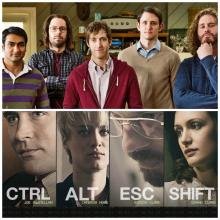
“THE COMPUTER’S not the thing. It’s the thing that will get us to the thing,” intones Joe MacMillan (Lee Pace), the enigmatic visionary at the heart of AMC’s new techno-drama Halt and Catch Fire. Set in the early 1980s in Texas’ “Silicon Prairie,” the series chronicles a small, fictional software company that enters the personal computing fray. This is the age of IBM dominance and the improbability of an underdog company taking down the computer Goliath is the premise of the show.
HCF is a kind of origin myth: a drama that tries to capture the spirit and personalities that drove the personal computing revolution that reshaped the world we now inhabit. Across the cable universe, HBO offers another riff on the same theme set in the present day. Silicon Valley is a satirical send-up of startup culture and the boy-men who rule the northern California empire to which we are all in thrall. In tone and style it is the antithesis of the self-consciously serious HCF. But the two shows share a similar preoccupation with exploring the humans who make technology even more than the technology itself.
This is partially a necessity of good storytelling. Nothing slows down a story like having to explain technical expertise. At best you can get a few gags out of the science geek spewing unintelligible jargon to the bewildered “everyperson” (think Sheldon’s whole persona on The Big Bang Theory). But this narrative limitation also hints at the enigma both shows are trying to explore: Who are the people who understand the jargon and create the technology that defines our new digital age? What is the nature of this kind of power?
During his 1930-31 fellowship at Union Theological Seminary in New York City, German theologian Dietrich Bonhoeffer joined his African American classmate Albert Fisher as a regular attendee at Abyssinian Baptist Church in Harlem.
WHEN BONHOEFFER entered Harlem with Fisher, he met a counternarrative to the white racist fiction of black subhumanity. The New Negro movement radically redefined the public and private characterization of black people. A seminal moment in African American history had arrived, and all of Bonhoeffer’s descriptions of his involvement in African American life during his Sloane Fellowship year occurred during this critical movement. He turned 25 that February. Bonhoeffer was experiencing that critical moment in African American history while he was still young and impressionable.
The New Negro, a book containing a collection of essays, was edited by one of the leading intellectual architects of the movement, Alain Locke. The New Negro, as Locke and his authors appropriated the term, described the embrace of a contradictory, assertive black self-image in Harlem to deflect the negative, dehumanizing historical depictions of black people. The New Negro made demands, not concessions: “demands for a new social order, demands that blacks fight back against terror and violence, demands that blacks reconsider new notions of beauty, demands that Africa be freed from the bonds of imperialism.” Bonhoeffer knew the movement by the descriptor New Negro, but James Weldon Johnson preferred to describe the movement as the Harlem Renaissance ... as a rebirth of black people rather than something completely new. ...
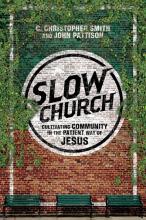
HERE’S WHAT Slow Church is not: A how-to manual with five easy steps to make your congregation more thoughtful. A celebration of how using the word “community” often on your church website will multiply your pledge and attendance numbers. An ode to really, really long worship services.
Rather, Slow Church explores being church in a way that emphasizes deep engagement in local people and places, quality over quantity, and in all things taking the long view—understanding individuals and congregations as participants in the unfolding drama of all creation. Authors C. Christopher Smith and John Pattison are self-proclaimed “amateurs,” insofar as they are writers-editors and lay leaders, not professional pastors, theologians, or congregational consultants. But this book is richly informed by their experience in their own church contexts (Englewood Christian Church in a gritty neighborhood in Indianapolis for Smith; an evangelical Quaker meeting in small-town Oregon for Pattison), conversations with other church communities, and close reading of classic and contemporary literature on culture, Christian community, scripture, and spirituality
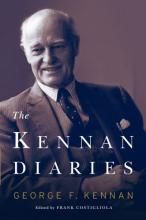
THE KENNAN DIARIES, carefully edited by Frank Costigliola, a University of Connecticut historian, covers an amazing and sometimes disturbing 88-year period of personal journal-writing by George F. Kennan, who became the most famous diplomat-intellectual of the 20th century.
Born in 1904 (he died in 2005) Kennan, a Milwaukee native, grew up in an upper-class Scotch-Irish Presbyterian family with three older sisters and a father who was a tax attorney.
After graduating from Princeton, Kennan became a Foreign Service officer with the State Department, eventually serving in posts throughout Europe. But Kennan’s first love was Russia. He wrote in his diary that “he had a mystical connection to Leningrad, as though he had once lived there.” He was offered a three-year university stint in Berlin by the State Department—Kennan’s boss wanted him to be educated like a pre-Bolshevik Russian gentleman. Kennan’s grasp of the Russian language and history became exceptional. Together with his prodigious analytical skills, it would be the foundation of his brilliant career.
After 20 years abroad, Kennan fired off his famous 5,540-word “Long Telegram” on Feb. 22, 1946, from Moscow to Washington. Soon afterward, in July 1947, he wrote another piece in Foreign Affairs under the byline “X.” In the two pieces he said that the Soviets under Stalin would try aggressively to expand, but that the U.S. should not employ military means to stop them. Instead, Kennan advocated “containment,” heavily monitoring the Russians with hard-headed diplomacy and tough talk. He also stated that the Soviet Union would eventually self-destruct.
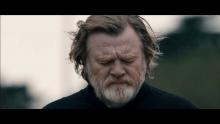
WHAT’S A GOOD priest for? So asks Calvary, the second feature film from writer-director John Michael McDonagh, rooting itself in Ireland’s coastal landscape, centering on a pastor threatened with scapegoat-retributive murder from a grievously sinned-against parishioner. Its vibe owes a great deal to the quiet reflection of films such as Jesus of Montreal and Au Hasard Balthazar (in which a donkey evokes the love and wounds of Christ), and the archetypal Westerns High Noon and Unforgiven. Brendan Gleeson plays a priest who was drawn into the church after his wife’s death, which allows us the rare experience of seeing a cinematic Catholic priest who is both a parent to his flock and to a beloved daughter, who feels somewhat abandoned by his commitment to the church.
Gleeson has the uncanny ability to hold his massive frame as both solid—almost concrete—and vulnerable. Knowing that everyone is both broken and breaker, his Father James is healing on behalf of a flawed institution, although he doesn’t confuse vocation with a job. His bishop’s response to a request for help is “I’m not saying anything,” reminding me of Daniel Berrigan’s challenge to religious hierarchies, heard at a public meeting in Dublin in the run-up to the Iraq war: “In Vietnam, they had nothing to say, and said nothing; now, they have nothing to say, and they’re saying it.”
Father James understands the difference between stewarding power and grabbing it (one obvious signal of his goodness), and he is up to his neck in the community, running the gamut from friendship with an American writer looking for inspiration in the land of his presumed ancestors to a visit with a former pupil whose own inner darkness has led him to do monstrous things.

IN 1961, President Eisenhower warned us about the threat to democracy posed by what he dubbed the military-industrial complex. Today we need an Eisenhower to sound the alarm about another threat to our capacity for self-rule: the educational-industrial complex.
The military-industrial complex gained power because it promised to protect Americans from the spectral threat of Soviet domination. The educational-industrial complex has arisen in response to the fear of economic domination by better-educated populations. But the policies it promotes could leave our population increasingly unable to think for itself or counter the saturating influence of propaganda—whether commercial or political.
What I mean by the educational-industrial complex is that vast network of companies and institutions with a vested interest in education policy: the testing companies, textbook publishers, software developers, technology peddlers, “for-profit” schools, and the armies of high-powered “consultants” that circle U.S. schools like vultures picking the last dollars from the emaciated bones of their budgets. All of these players push an agenda of standardized testing and skills-based curricula that is crowding out both content knowledge (outside of science and math) and the slow, labor-intensive process of reading and discussion that produces the capacity for critical thinking. In the end, we’ll have a deeply ignorant and complacent people who will do as they’re told and buy what they’re sold.
I see this narrowing of educational horizons even in my little corner of the higher education world. At our small state university, faculty members are regularly subjected to lengthy presentations from hired consultants deployed to update our pedagogy—or at least our ed-speak jargon. For instance, last year all teaching faculty had to submit measurable “Student Learning Outcomes,” unfortunately abbreviated “SLO,” for every course we teach. When most of our “outcomes” were deemed “unmeasurable,” a SLO consultant was loosed upon us. From his presentation I learned that an “outcome” was really the same thing that, a decade ago, another consultant called learning “objectives.” In fact, in the middle, our SLO guy started using the two terms interchangeably, leading me to suspect that he had simply changed the jargon in an old presentation and missed a few spots when he did.
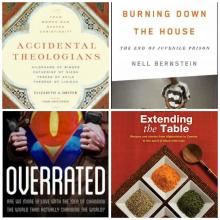
Church Makers
In Accidental Theologians: Four Women Who Shaped Christianity, Elizabeth A. Dreyer delves into the theology of four female saints of the Catholic Church, Hildegard of Bingen, Catherine of Siena, Teresa of Avila, and Thérèse of Lisieux, describing their impact on the church in their times and today. Franciscan Media
Global Feast
The revised edition of Extending the Table cookbook (first released in 1991) includes new dishes, regional menus, and more photos, as well as prayers and stories. It is part of the World Community Cookbook series commissioned by Mennonite Central Committee, and royalties support MCC’s work. Herald Press
PRIOR TO MY conversion to Christianity, I was the roving reggae reporter for High Times, a magazine dedicated to marijuana culture. I also wrote music reviews for NY Press, Virgin Records, and various other publications.
One of my favorite artists from the early 2000s was Cody Chesnutt (he spells his name with two capital Ts at the end), an independent recording artist popularly known for his hit song “Seed 2.0,” a soulful rock and hip-hop hybrid released in 2002 with The Roots.
Chesnutt’s musical debut was a lo-fi soul and rock-and-roll album titled The Headphone Masterpiece. It was a double disc (this was still the heyday of compact discs) that he recorded on a 4-track recorder in the bedroom of his Los Angeles apartment. He played all the instruments—guitar, bass, keyboard, and organ. The sound quality and lyrical content are both intentionally gritty.
Headphone quickly became the soundtrack to my college years. I was a reveler, filled with hypersexual bravado and abundant egotism, and Chesnutt’s music reinforced and undergirded my misdirected youthful zeal. His lyrics were unrepentantly misogynistic, and his strong sense of self pervaded each track. He exploited his infidelity and womanizing in his music, at times in a prophetic way, such as in “My Women, My Guitars,” which he opens with incredibly crude lyrics, but later croons with utmost vulnerability: “Man, something’s been killing me. My women, my guitars. I’ve been living hard. My breakdown is on the way. I know my breakdown is on the way. So I get up on my feet. Falling back on my knees to pray.”
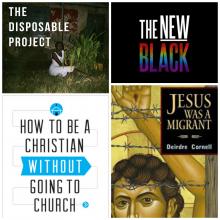
THROUGH THEIR EYES
In 2011, Raul Guerrero provided 100 Kodak disposable cameras and taught basic photography skills to nine young students in the Newlands area of Moshi, Tanzania. The Disposable Project book brings together their images of their community, with text by Guerrero. the-disposable-project.com
JOURNEYING
“Migration has been, for centuries, not only a source of controversy but a source of blessing,” Deirdre Cornell writes in Jesus Was a Migrant. Inspired by ministering among immigrants in different settings, this is a beautifully written set of deeply humanizing reflections on the immigrant experience and Christian spirituality. Orbis Books
AMID WORRIES about a new Cold War, of standoffs with old enemies and confrontations with new ones, Harvard professor Elaine Scarry’s latest book is a chilling reminder of the doom our presidentially controlled nuclear arsenal can unleash upon the world. Early on, she reminds us that President Nixon told reporters, “I can get on the telephone and in 25 minutes 70 million people will be dead.”
This boast illustrates Scarry’s thesis: We live in a thermonuclear monarchy, where one person—the U.S. president—can destroy the world. Nuclear doom is an accident waiting to happen, and she reviews a number of barely publicized near misses.
But she sees a solution at hand—the U.S. Constitution, specifically both Article I, Section 8, which says that Congress alone can declare war, and the Second Amendment. The text of the latter reads: “A well regulated militia being necessary to the security of a free state, the right of the people to keep and bear arms shall not be infringed.” (Emphasis added.) Scarry argues that the amendment mandates a second level of citizen consent to war, a further brake to executive power, even after Congress has given its approval—that the writers of the Constitution intended that before the U.S. engaged in any war the people would have to consent to join a militia, a form of collective participation in the decision for war. According to Scarry, our out-of-ratio nuclear weapons stockpile, ready to launch at the command of a single person, has negated the Constitution-mandated chain of accountability and decision-making and is therefore illegal.
FAITH-ROOTED Organizing: Mobilizing the Church in Service to the World outlines a theological cartography of social change. In this critical intervention, Alexia Salvatierra and Peter Heltzel reimagine—and as a necessary consequence, rechart—the landscape of vision, action, and strategic planning needed for social change.
Full disclosure: I have attended several trainings conducted by the co-authors. Indeed, the dual authorship of the text is a principal strength. Faith-Rooted Organizing blends the voice of an evangelical-activist theologian in Heltzel with the homespun profundity of a seasoned pastor and campaign organizer in Salvatierra. The authors delight readers with complementary writing styles: Heltzel speaks through theological propositions, interpolated intermittently with jazz references and theological punch lines; Salvatierra communicates through proverbs, organizing anecdotes, poignant biblical passages, and narrative side notes.
The result is a well-argued and accessible text that should resonate from the seminary to the sanctuary. Their driving thesis is that faith communities, especially Christian ones, should organize for social change in a way that is rooted and guided by the stories, symbols, sayings, and scriptures of our faith. Faith-Rooted Organizing functions as an instruction manual on effective advocacy while providing a theological rationale and vocabulary for a vocation marked by tremendous victories and colossal failures, breakthrough partnerships and fragmented coalitions, glimpses of beloved community and portraits of democracy stillborn.

WHAT IS THE relationship between one’s religious beliefs and one’s economic and political views? Are some religious beliefs more “American” than others?
These questions come to mind in reading Samuel Gregg’s Tea Party Catholic: The Catholic Case for Limited Government, a Free Economy, and Human Flourishing. Gregg suggests that religion directly informs—or should inform—our understanding of political and economic issues and that religious, economic, and political liberty are inextricably bound. A perceived or real “attack” on one, he contends, is an attack on all.
Gregg is director of research for Acton Institute, a libertarian think tank whose core principles seek the “integrating [of] Judeo-Christian truths with free market principles.”
In Tea Party Catholic Gregg writes of a “new type of Catholic American” who is grounded in a “dynamic sense of orthodoxy” but whose “Americanness” is defined by faith in free market principles. Tea Party Catholic details how free market principles and a view of government “with clear but constrained economic functions” have, Gregg argues, not only deep roots in U.S. political history but also in Catholic tradition. Thereby, he suggests, any U.S. Catholic differing in his or her economic and political beliefs has neither a proper understanding of the United States’ founding nor of the teachings of the Catholic Church.
Gregg’s attempt to sacralize libertarianism is not consistent with Catholic doctrine: It runs counter to stated positions of the Vatican and the majority of Catholic theologians and economists. At a recent conference at The Catholic University of America one of Pope Francis’ advisers, Cardinal Oscar Rodríguez Maradiaga, said that in commenting on free market and libertarian influences on our global economy, Pope Francis gave a “sharp prophetic verdict: ‘This economy kills.’”
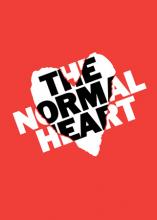
IT’S A TRUISM to say that television is outpacing cinema for entertainment quality and depth of exploration. Since The Wire appeared a decade ago, studios have been realizing that there is an audience for long-form storytelling that is willing to think.
Recently I’ve been struck by the set-in-the-’80s espionage thriller The Americans, the deeply haunting police procedural True Detective, the hilarious pathos of Louie and Veep, and the sly, shocking Hannibal, a prequel to The Silence of the Lambs: All hugely entertaining, dramatically credible, and challenging both as works that require sustained attention and in terms of what they say about life. The Americans is really an exploration of marriage and cultural identity wrapped up in Cold War cloaks-and-daggers; True Detective is a lament for the broken parts of America, and an affirmation that friendship endures above almost everything else; and Hannibal is a postmodern delving into Dante’s Inferno, looking at the underbelly of Aleksandr Solzhenitsyn’s assertion that “the line dividing good and evil cuts through the heart of every human being.”
What’s most exciting is that it’s now considered viable to make drama that actually asks real questions about life and is prepared not to answer them pat. Along with the vast amount of social media conversation about these works, what we have is more akin to ancient forms of public entertainment that required a kind of audience participation—theatrical catharsis meeting gathered conversation to produce a community hermeneutic. When we talk about TV and cinema, we’re talking about ourselves.

THE CONTROVERSY over net neutrality has come back to the Federal Communications Commission (FCC) where it began, and the commissioners need to hear, immediately, one simple message from ordinary citizens: “Reclassify broadband internet as a telecommunications service.”
You don’t really even need to know what those seven words mean. Just say them—by phone, email, fax, or carrier pigeon—until the commissioners get the idea.
That imperative sentence is aimed at preventing a policy shift that could turn our information superhighway into a fast, expensive toll road for the wealthy and force ordinary citizens onto a two-lane frontage road, with lots of traffic lights.
Net neutrality, as you may recall, is the principle that internet service providers—the companies that own the cable or the wireless frequencies that bring the internet to your device—should treat all digital content the same. Comcast shouldn’t block Amazon Prime to force you into its own video-on-demand service, and Verizon shouldn’t let Netflix pay more to get higher download speeds than its competitors. As a corollary, this means that independent filmmakers and video journalists have the same access to the online audience that the corporate big boys have.
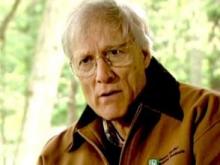
WALTER WINK IS known as a lectionary commentator with lucid biblical insight, a chronicler of nonviolent practice, a scholarly essayist, an arrestee in direct action, and one of the most important theologians of the millennium’s turn. He effectively named “the domination system” and its collusive principalities, opened up biblical interpretation to an integrated worldview, and brought the New Testament language of power back on the map of Christian social ethics.
Two years ago he crossed over to God, joining the ancestors and saints. His first two posthumous books have now appeared. They make for good companion volumes. Let me weave back and forth between the two. Walter Wink: Collected Readings is the anthology of his core work. Just Jesus: My Struggle to Become Human is a short autobiography. The second is the more remarkable—because it’s so rare that a world-class scripture scholar should tell his or her own story in relation to encounters with the biblical witness. And all the more so because it was a project undertaken after he was diagnosed with Lewy body dementia.
Given the dementia, the book itself is an effort of his “struggle to become human.” An early version of the manuscript included oral history and other sources narratively adapted to a first-person voice, but in the end his partner in all things, June Keener Wink, pressed for it to be pure Walter. No words not his own. His voice is easily recognized in these pages, though not always in the familiar crafted and noted style, rich in quotable one-liners. The jewels are here all right, but this text feels simpler, sparer, plainer. There are prayers and memories of one suffering the weight and creep of memory loss. Though it is a book he conceived and set to writing, June (aided by a sainted editor) lovingly completed the sculpture with autobiographical pieces, journal entries, prayers, dreams, and important portions of his final magisterial work, The Human Being: Jesus and the Enigma of the Son of the Man. The latter, also well represented in Collected Readings, frames the struggle (Jesus’, Walter’s, and our own) to become human.
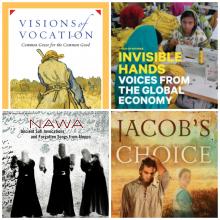
Life with Purpose
In Visions of Vocation: Common Grace for the Common Good, Steven Garber writes eloquently of the challenge "to see with the eyes of the heart, to see oneself as responsible for the way the world is and isn't" without succumbing to cynicism. IVP Books
Saved Songs
Just months before civil war erupted in Syria, a small group of Syria Sufi musicians known as NAWA were recorded peforming nearly lsot melodies, songs, and poems on Ancient Sufi Invocations and Forgotten Songs from Aleppo. This is the first album in a planned four-part Sacred Voices of Syria series. Cowbell/Lost Origins
YOU DON’T HAVE to be an environmentalist to wonder about technology. Will it be our great savior or another thorn in the flesh, another opportunity to hear Thoreau’s lament about the tendency of humans to “become the tools of their tools”?
This excellent collection of prayers and worship materials, From the Psalms to the Cloud, helps us understand the tool of technology. It is a very green book while also being useful. It is green because it gives us a way out of the totalitarian world of the market and into a world that we make with words.
Just about everybody is on the other side of the “time famine” and the “trust famine” and deep into digital and connectivity overload. By time famine I mean the pervasive sense that there is not enough time to do what we want, so subjugated is our time to technology, forms, and robotic requests for information. By trust famine I mean all that time we spend worrying about time and wondering if somebody else is in charge. Are we in charge of our tools and our time or are our tools and time in charge of us?
In this optimistic book, the prophets arrive. Mankin and Tirabassi ask the right question: Can a technology devoted to advertising be useful to spirituality? They answer with a careful yes, taking us on the long road from the Psalms to Twitter, by way of “vintage wine in vintage wineskins, uncorked.” These two writers gather the wisdom of dozens of beautiful writers of prayers and liturgies and show us a way to go deep digitally. Whether they are praying for energy that will “deeply change all of our clocks,” or for the return of the time when churches giving sanctuary for immigrants will become again “dusty places with pews,” or in any of John Dannon’s exquisite doxologies for the natural and ecclesiastical seasons, or encouraging us to “spend a day saying nothing that doesn’t need saying.” The prayer topics move through addiction to pregnancy to a ritual for quitting a job. What a great ask this is for those confused or overdone with technology: We pray “for a trap door when we hit rock bottom.”
FORGIVENESS IS wholeness, Nobel Peace Prize winner Archbishop Desmond Tutu and his daughter, Anglican minister Rev. Mpho Tutu, write in their newest collaboration,The Book of Forgiving. Scientific research shows that forgiveness has the power to transform us in spiritual, emotional, and even physical ways. That evidence is paired with the Tutus’ collective experience in counseling, studying, and teaching and their personal stories about the difficulty of forgiving. Archbishop Tutu writes about learning to forgive his abusive father. Mpho, who writes about learning to forgive the man who murdered her housekeeper in her home, is pursuing a PhD in the topic of forgiveness.
The book lays out some simple but critical truths: Everyone can be forgiven. Everyone deserves forgiveness. You must be willing to forgive. Forgiveness is not a weakness, nor a luxury. Forgiving others is a way to practice forgiving yourself. Through forgiveness, we all become whole again. Unconditional forgiveness is an act of grace that frees all parties from further indignity, and from self-blame and corrosive hatred.
The path to forgiveness seems simple enough when you can navigate it in four easy-to-follow steps: Tell the story. Name the hurt. Grant forgiveness. Renew or release the relationship. The path is also—sorry—a bit pedestrian. That doesn’t mean the route map isn’t useful. But the book will be most applicable if you have struggled to forgive or feel that even contemplating forgiveness is an impossible burden weighing heavy on your heart and soul. If you’re carrying a load you can’t seem to gracefully shrug off or leave by the side of the road, the Tutus can help you chart the course.